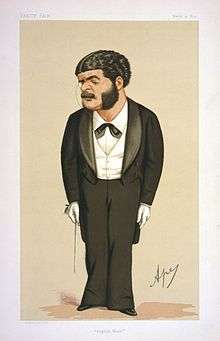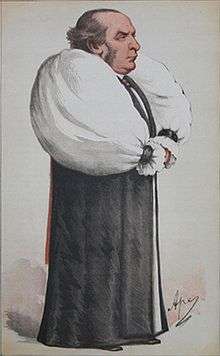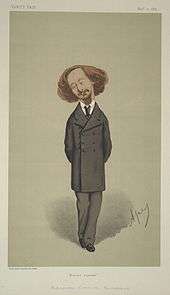Carlo Pellegrini (caricaturist)


Carlo Pellegrini (25 March 1839 – 22 January 1889), nicknamed Ape (Italian for "bee"), was an artist who served from 1869 to 1889 as a caricaturist for Vanity Fair magazine, a leading journal of London society. He was born in Capua, then in the Kingdom of the Two Sicilies. His father came from an ancient land-owning family, while his mother was allegedly descended from the Medici. His work for the magazine made his reputation and he became its most influential artist.
Early life
Pellegrini was educated at the Collegio Barnibiti, and then at Sant' Antonio in Maddaloni, near Naples. As a young man he caricatured Neapolitan society, modelling his portraits on those of Melchiorre Delfico and Daumier and other French and British artists of the period. Pellegrini claimed to have fought with Garibaldi; however, those who knew him well dismissed this as fantasy.
Deciding to leave Italy in 1864 after a series of personal crises, including the death of his sister, he travelled to England via Switzerland and France. He arrived in London in November 1864; he later claimed to have arrived destitute, and to have slept on the streets and in doorways. However, this claim may have been another fantasy designed to make him seem to be a Bohemian artist. In London he became a friend of the Prince of Wales.[1]
Work for Vanity Fair
It is not recorded how Pellegrini met Thomas Bowles, the owner of Vanity Fair magazine, but he quickly found himself employed by that publication and became its first caricaturist, originally signing his work as 'Singe' and later, and more famously, as 'Ape' (Italian for Bee). Pellegrini's work for the magazine made his reputation and he became its most influential artist, in which his caricatures were to be printed for over twenty years, from January 1869 to April 1889. His 1869 caricature of Benjamin Disraeli was the first colour lithograph to appear in the magazine, and proved immensely popular. It was the first of a highly successful series of more than two thousand caricatures published by Vanity Fair. Although the later caricatures by Sir Leslie Ward are perhaps now more well known, those by 'Ape' are regarded by many collectors as being artistically and technically superior.
Apart from drawing his caricatures for the magazine Pellegrini attempted to set himself up as a portrait painter, but this venture met with limited success. Pellegrini met Degas in London in the 1870s, and in about 1876–77 painted his portrait, inscribed 'à vous/Pellegrini' (to you/Pellegrini). In return, Degas painted Pellegrini's portrait, similarly inscribed.
Pellegrini was a member of the Beefsteak Club in London and there met Whistler, who became a great influence on his work; indeed, he even attempted to paint portraits in the style of Whistler, but, as said earlier, this venture met with limited success. Pellegrini was also a member of The Arts Club from 1874 until 1888.
Pellegrini was extremely careful about his appearance, and would wear immaculate white spats with highly polished boots. He grew long Mandarin-like fingernails, would never walk when he could ride, and had a limitless fund of amusing stories and eccentricities. He spoke broken-English, flaunted his homosexuality (at a time when it was dangerous to do so), and would often bring macaroni dishes to elegant dinner parties. He would refuse invitations to country houses out of fear of strange beds, and had a habit of keeping a cigar in his mouth as he slept.[2]
He died of lung disease at his home, 53 Mortimer Street, near Cavendish Square in London. He is buried in St. Mary's Roman Catholic Cemetery, Kensal Green, London.
See also
Gallery


 A unique statuette in terracotta by Pellegrini of Robert Lowe dated 1873
A unique statuette in terracotta by Pellegrini of Robert Lowe dated 1873

_from_Vanity_Fair_Issue_812%2C_April_1884..jpg)





 Pellegrini by Sir Henry Thompson
Pellegrini by Sir Henry Thompson
References
External links
| Wikimedia Commons has media related to Carlo Pellegrini (caricaturist). |
- Some of his caricatures at the National Portrait Gallery
This article incorporates text from a publication now in the public domain: Wood, James, ed. (1907). "article name needed". The Nuttall Encyclopædia. London and New York: Frederick Warne.